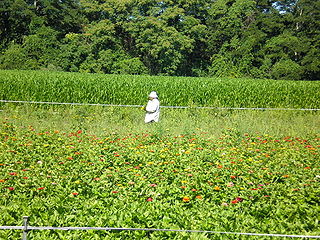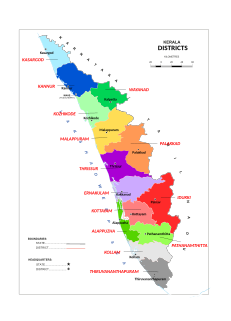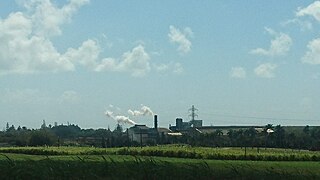Related Research Articles

Debt bondage, also known as debt slavery, bonded labour, or peonage, is the pledge of a person's services as security for the repayment for a debt or other obligation, where the terms of the repayment are not clearly or reasonably stated, and the person who is holding the debt thus has some control over the laborer. Freedom is assumed on debt repayment. The services required to repay the debt may be undefined, and the services' duration may be undefined, thus allowing the person supposedly owed the debt to demand services indefinitely. Debt bondage can be passed on from generation to generation.

A sweatshop or sweat factory is a crowded workplace with very poor, socially unacceptable or illegal working conditions. Some illegal working conditions include poor ventilation, little to no breaks, inadequate work space, insufficient lighting, or uncomfortably high temperatures. The work may be difficult, tiresome, dangerous, climatically challenging or underpaid. Workers in sweatshops may work long hours with unfair wages, regardless of laws mandating overtime pay or a minimum wage; child labor laws may also be violated. Women make up 85 to 90% of sweatshop workers, some employers force them to take birth control and routine pregnancy tests to avoid supporting maternity leave or providing health benefits. The Fair Labor Association's "2006 Annual Public Report" inspected factories for FLA compliance in 18 countries including Bangladesh, El Salvador, Colombia, Guatemala, Malaysia, Thailand, Tunisia, Turkey, China, India, Vietnam, Honduras, Indonesia, Brazil, Mexico, and the US. The U.S. Department of Labor's "2015 Findings on the Worst Forms of Child Labor" found that "18 countries did not meet the International Labour Organization's recommendation for an adequate number of inspectors."

Foreign workers or guest workers are people who work in a country other than one of which they are a citizen. Some foreign workers use a guest worker program in a country with more preferred job prospects than in their home country. Guest workers are often either sent or invited to work outside their home country, or have acquired a job before they leave their home country, whereas migrant workers often leave their home country without having a specific job in prospect.
Indo-Caribbeans or Indian-Caribbeans are people in the Caribbean who are descendants of the jahaji Indian indentured workers brought by the British, Dutch, and French during the colonial era from the mid-19th century to the early 20th century. A minority are descendants of Indians or other South Asians who immigrated as entrepreneurs, businesspeople, engineers, doctors, etc. beginning in the mid-20th century.

A migrant worker is a person who migrates within a home country or outside it to pursue work. Migrant workers usually do not have the intention to stay permanently in the country or region in which they work.
Prostitution in Nepal is illegal. The Human Trafficking and Transportation (Control) Act, 2064, Act Number 5 of the Year 2064 (2008), criminalises prostitution and living of the earnings of prostitution by including it in the definition of human trafficking. UNAIDS estimate there to be 67,300 prostitutes in the country.

The Bangladeshi diaspora consists of people of Bangladeshi descent who have immigrated to or were born in another country. First-generation migrants may have moved abroad from Bangladesh for various reasons including better living conditions, to escape poverty, to support their financial condition, or to send money back to families there. With a total of thirteen million Bangladeshis living abroad, the country has ranked fourth among the top 20 countries of origin for international migrants. Annual remittances received in Bangladesh were $13.4 million in 2017.
Nepalese in South Korea comprise Korean Citizens and Nepalese migrant workers, including temporary expatriates and permanent residents, as well as their locally born descendants of either Korean or Nepalese nationality. The Nepalese in South Korea are mainly of four distinct ethnic groups : Bahun (Brahmins), Chhetri (Rajputs), Madhesis and Janjatis.
Nepalis in Japan comprise migrants from Nepal to Japan, including temporary expatriates and permanent residents, as well as their locally born descendants. As of 2017, there are about 80,038 Nepalis living in Japan, which makes them the largest South Asian community in the country.
Bangladesh is a source and transit country for men, women, and children subjected to trafficking in persons, specifically forced labor and forced prostitution. A significant share of Bangladesh's trafficking victims are men recruited for work overseas with fraudulent employment offers who are subsequently exploited under conditions of forced labor or debt bondage. Children – both boys and girls – are trafficked within Bangladesh for commercial sexual exploitation, bonded labor, and forced labor. Some children are sold into bondage by their parents, while others are induced into labor or commercial sexual exploitation through fraud and physical coercion. Women and children from Bangladesh are also trafficked to India for commercial sexual exploitation.
Human trafficking in Nepal is a growing criminal industry affecting multiple other countries beyond Nepal, primarily across Asia and the Middle East. Nepal is mainly a source country for men, women and children subjected to the forced labor and sex trafficking. U.S. State Department's Office to Monitor and Combat Trafficking in Persons placed the country in "Tier 2" in 2017.
The Maldives is primarily a destination country for migrant workers from Bangladesh, and, to a lesser extent, India, some of whom are subjected to trafficking in persons, specifically forced labor. Some women are also subjected to forced prostitution. An unknown number of the 110,000 foreign workers currently working in the Maldives – primarily in the construction and service sectors – face fraudulent recruitment practices, confiscation of identity and travel documents, withholding or non-payment of wages, or debt bondage. Thirty thousand of these workers do not have legal status in the country, though both legal and illegal workers were vulnerable to conditions of forced labor. Diplomatic sources estimate that half of the 35,000 Bangladeshis in the Maldives went there illegally and that most of these workers are probably victims of trafficking. Migrant workers pay $1,000 to $4,000 in recruitment fees in order to migrate to the Maldives; such high recruitment costs increase workers’ vulnerability to forced labor, as concluded in a recent ILO report.
Most expatriates in the United Arab Emirates reside in Dubai and Abu Dhabi. A number of immigrants settled in the country prior to independence. The UAE is home to over 200 nationalities. Emiratis constitute roughly 20% of the total population, making UAE home to one of the world's highest percentage of expatriates. Indians and Pakistanis form the largest expatriate groups in the country, constituting 28% and 12% of the total population respectively. 461,000 Westerners live in the United Arab Emirates, making up 5.1% of its total population.
Nepalis in Qatar are migrants from Nepal to Qatar, mostly migrant workers and permanent residents, as well as their locally born descendants. As of May 2017, 400 thousand Nepali Citizens lived in Qatar as migrant workers, Nepal is the second largest expatriate community in Qatar. While there are Nepalese working in the business and administrative sectors of Qatar, most workers from Nepal fall under the umbrella of unskilled labor, and hold jobs in sectors such as construction and landscaping. Many workers from Nepal are hired to work on the construction of stadiums and railways that are being designed for the 2022 FIFA World Cup to be held in Qatar. According to Time Magazine, due to the terrible working conditions in Qatar, a Nepali worker dies every other day.
Nepalis in Saudi Arabia are immigrants from Nepal to the Kingdom of Saudi Arabia, mostly migrant workers and expatriates. Saudi Arabia has emerged as one of the top destinations for migrant Nepalese laborers. Approximately 300,000 Nepalese laborers, skilled and semi-skilled, work in the country of which mostly belongs to Madhesi Race totalling up to 199,757 according to IOM Report of 2012-2014 and remaining are predominantly belong to Bahun and Chhetri ethnicity.
Nepalis in Poland are migrants from Nepal to Poland, mainly expatriate workers and international students.

Migrant labourers in Kerala, India's southernmost state, are a significant economic force in the state; there were around 2.5 million internal migrants in Kerala according to a 2013 study by the Gulati Institute of Finance and Taxation. Every year, the migrant worker population in Kerala increases by 2.35 lakh (235,000) people. The study, based on long-distance trains terminating in Kerala, does not cover migrants from the neighbouring states who use other modes of transport. Assuming that the estimation is rigorous and extrapolating it, taking into account the net annual addition, possible growth in migration rate, as well as accounting for the migration from the neighbouring states, Kerala is likely to have 5 to 5.5 million inter-state migrant workers in 2020. Despite their importance and despite many of them praising the state for its welfare schemes and environment, they are often ignored in comparison and suffer from comparatively poor living conditions.
Migrant workers in the United Arab Emirates describe the alien foreign workers who have moved to the United Arab Emirates (UAE) for work. As a result of the proximity of the UAE to South Asia and a better economy and job opportunities, most of the migrant foreign workers are from India, Nepal, Sri Lanka, Bangladesh, and Pakistan.
Migrant workers in the Gulf Cooperation Council region involves the prevalence of migrant workers in the Kingdom of Bahrain, the State of Kuwait, the Sultanate of Oman, the State of Qatar, the Kingdom of Saudi Arabia and the United Arab Emirates (UAE). Together, these six countries form the Gulf Cooperation Council (GCC), established in 1981. The GCC cooperates on issues related to economy and politics, and the subject of migrant workers constitutes a substantial part of the council's collaboration. All of the GCC countries are dependent on migrant labor to bolster and stimulate economic growth and development, as the GCC countries possess an abundance of capital while the domestic labor capacity is low. Although migrant workers in the Persian Gulf region amount to no more than 10% of all migrants worldwide, they constitute a significant part of the populations of their host countries.

The Uba riots of 1937 or simply the Mauritian riots of 1937 refers to an outbreak of riots and civil disturbances that broke out amongst small scale sugar cane growers on the island of Mauritius in August 1937. The riots led to the death of 4 people with an additional 6 people being injured.
References
- ↑ : MYREPUBLICA.com - Mauritius eyes Nepali workers
- ↑ ": kotzot.com - Bangladeshi and Nepali workers protest about 'inhumane' conditions in which they are expected to live in Mauritius". Archived from the original on 2011-05-10. Retrieved 2011-06-15.